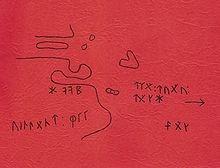Spirit Pond runestones


The Spirit Pond runestones are three stones with alleged runic inscriptions, found at Spirit Pond in Phippsburg, Maine in 1971 by a Walter J. Elliott Jr., a carpenter born in Bath, Maine. The stones, currently housed at the Maine State Museum, are widely dismissed as a hoax or a fraud.[1][2]
Reception
[edit]Unlike the prehistoric monumental runestones raised in Scandinavia, the Maine stones are small handheld objects similar to the authentic Kingittorsuaq Runestone found in Greenland in 1824.
Of the three stones, one contains a total of 15 lines of 'text' on two sides. The map stone contains a map with some inscriptions. Paul H. Chapman proposes that the map depicts the landscape visible from the 1,075 feet (328 m) high White Mountain, the highest point in the vicinity of Spirit Pond,[3] or the northern tip of Newfoundland.[4]
The inscriptions contain several instances of the use of pentadic numerals in European digits placement. The first to study the stones scientifically was Harvard University professor Einar Haugen. In 1974, after transcribing, he found the individual runes used to be inconsistent with 11th century Old Norse, and that the text contains only "a few Norse words in a sea of gibberish".[2] He also noted peculiarities relating the inscriptions directly to the Kensington Runestone inscription. Thus, he concluded that the inscriptions were most likely created after 1932.[2]
Amateur researchers have been more sympathetic to a medieval origin of the stones. Suzanne Carlson of NEARA, a group of enthusiasts who believe there was a widespread Viking presence in North America, suggests a mid 14th century date for the inscriptions, although it is unclear how Carlson arrived at this date.[5][6] Similarly, amateur rune-enthusiast Richard Nielsen claims a precise date of 1401.[7]
See also
[edit]- Maine penny, a Norwegian coin supposedly found in a prehistoric Maine archaeological site
References
[edit]- ^ Snow, Dean R. (October/November 1981). "Martians & Vikings, Maldoc & Runes". American Heritage Magazine 32(6). Archived from the original on September 29, 2007.
- ^ a b c Haugen, Einar (1974). "The Rune Stones of Spirit Pond, Maine". Visible Language 8(1).
- ^ Chapman, Paul H. (July/September 2005). "Where in North America did the Vikings settle?" Archived 2009-05-25 at the Wayback Machine The Ensign Message 7(3).
- ^ Chapman, Paul H. (1992). "An In-Depth Examination of the Spirit Pond Runestones". Epigraphic Society Occasional Papers 21. pp. 114-138.
- ^ Carlson, Suzanne. "The Spirit Pond Stones and the mysterious "facts" of their fabrication". Archived from the original on 2012-02-05.
- ^ New England Antiquities Research Association.
- ^ Nielsen, Richard (1993). "An Old Norse Translation of the Spirit Pond Runic Inscriptions of Maine". Epigraphic Society Occasional Papers 22(1). pp. 158-218.
Further reading
[edit]- Wahlgren, Erik (1982). American Runes: From Kensington to Spirit Pond. University of Illinois Press.
External links
[edit]- Transcription of Spirit Pond Number 3 (Figure 109) - Facsimile of "inscription stone"
